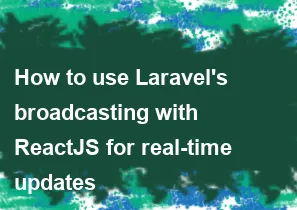How to use Laravel's broadcasting with ReactJS for real-time updates

To use Laravel's broadcasting feature with ReactJS for real-time updates, you can follow these general steps. Laravel provides broadcasting through Laravel Echo and Pusher by default, but you can also use other broadcasting drivers.
Here's a step-by-step guide:
1. Set up Laravel Broadcasting
Install Laravel Echo and Pusher:
bashcomposer require pusher/pusher-php-server npm install --save laravel-echo pusher-jsConfigure
.env: Add your Pusher credentials to your.envfile:envBROADCAST_DRIVER=pusher PUSHER_APP_ID=your-app-id PUSHER_APP_KEY=your-app-key PUSHER_APP_SECRET=your-app-secret PUSHER_APP_CLUSTER=your-app-clusterConfigure
broadcasting.php: Set up your broadcasting configuration inconfig/broadcasting.php:php'connections' => [ 'pusher' => [ 'driver' => 'pusher', 'key' => env('PUSHER_APP_KEY'), 'secret' => env('PUSHER_APP_SECRET'), 'app_id' => env('PUSHER_APP_ID'), 'options' => [ 'cluster' => env('PUSHER_APP_CLUSTER'), 'encrypted' => true, ], ], ],Set up Events: Create an event class that extends
Illuminate\Contracts\Broadcasting\ShouldBroadcastfor the data you want to broadcast. Example:php// app/Events/UpdateEvent.php use Illuminate\Broadcasting\Channel; use Illuminate\Broadcasting\InteractsWithSockets; use Illuminate\Broadcasting\PresenceChannel; use Illuminate\Broadcasting\PrivateChannel; use Illuminate\Contracts\Broadcasting\ShouldBroadcast; class UpdateEvent implements ShouldBroadcast { public $data; public function __construct($data) { $this->data = $data; } public function broadcastOn() { return new Channel('updates'); } }Broadcast the Event: In your controller or wherever you want to broadcast the event, use:
phpbroadcast(new UpdateEvent($yourData));
2. Set up Laravel Echo in ReactJS
Install Laravel Echo and Pusher in ReactJS:
bashnpm install --save laravel-echo pusher-jsConfigure Laravel Echo: Set up Laravel Echo in your ReactJS application. For example, in your main JavaScript file:
jsximport Echo from 'laravel-echo'; window.Echo = new Echo({ broadcaster: 'pusher', key: process.env.REACT_APP_PUSHER_APP_KEY, cluster: process.env.REACT_APP_PUSHER_APP_CLUSTER, encrypted: true, });Listen for Events: Wherever you want to listen for events (e.g., a React component), you can use the following:
jsxuseEffect(() => { window.Echo.channel('updates').listen('UpdateEvent', (event) => { console.log('Event received:', event); // Update your React component with the received data }); return () => { // Clean up event listeners when the component unmounts window.Echo.leaveChannel('updates'); }; }, []);
3. Start Broadcasting
Make sure you have your Laravel development server running and your ReactJS application up. Laravel Echo will handle the connection between the two.
When you trigger an event in Laravel, the ReactJS component should receive the event and update accordingly.
Note: This example uses Pusher as the broadcasting driver. If you use a different driver, adjust the configurations accordingly.
-
Popular Post
- How to optimize for Google's About This Result feature for local businesses
- How to implement multi-language support in an Express.js application
- How to handle and optimize for changes in mobile search behavior
- How to handle CORS in a Node.js application
- How to use Vue.js with a UI framework (e.g., Vuetify, Element UI)
- How to configure Laravel Telescope for monitoring and profiling API requests
- How to create a command-line tool using the Commander.js library in Node.js
- How to implement code splitting in a React.js application
- How to use the AWS SDK for Node.js to interact with various AWS services
- How to use the Node.js Stream API for efficient data processing
- How to implement a cookie parser middleware in Node.js
- How to implement WebSockets for real-time communication in React
-
Latest Post
- How to implement a dynamic form with dynamic field styling based on user input in Next.js
- How to create a custom hook for handling user interactions with the browser's device motion in Next.js
- How to create a custom hook for handling user interactions with the browser's battery status in Next.js
- How to implement a dynamic form with dynamic field visibility based on user input in Next.js
- How to implement a dynamic form with real-time collaboration features in Next.js
- How to create a custom hook for handling user interactions with the browser's media devices in Next.js
- How to use the useSWRInfinite hook for paginating data with a custom loading indicator in Next.js
- How to create a custom hook for handling user interactions with the browser's network status in Next.js
- How to create a custom hook for handling user interactions with the browser's location in Next.js
- How to implement a dynamic form with multi-language support in Next.js
- How to create a custom hook for handling user interactions with the browser's ambient light sensor in Next.js
- How to use the useHover hook for creating interactive image zoom effects in Next.js